I'm a fairly newe programmer and this is the first time I develop a game and I wanted to start with something pretty simple, so I chose the snake game. I have coded everything apart from adding the body part when the food is eaten.
import random
import pygame
from pygame import *
import sys
import os
import time
###objects
class snake:
def __init__(self, win):
self.score = 1
self.length = 25
self.width = 25
self.win = win
self.r = random.randint(0,500)
self.vel = 25
self.update = pygame.display.update()
self.right = True
self.left = False
self.up = False
self.down = False
# 0 = right 1 = left 2 = up 3 = down
self.can = [True, False, True, True]
self.keys = pygame.key.get_pressed()
while True:
if self.r % 25 == 0:
break
else:
self.r = random.randint(0,500)
continue
self.x = self.r
self.y = self.r
self.r = random.randint(0,500)
while True:
if self.r % 25 == 0:
break
else:
self.r = random.randint(0,500)
continue
self.a = self.r
self.b = self.r
def move(self, win):
win.fill((0,0,0))
self.keys = pygame.key.get_pressed()
if self.right == True:
self.x += self.vel
if self.left == True:
self.x -= self.vel
if self.up == True:
self.y -= self.vel
if self.down == True:
self.y += self.vel
if self.x > 475:
self.x = 0
if self.x < 0:
self.x = 500
if self.y > 475:
self.y = 0
if self.y < 0:
self.y = 500
if self.keys[pygame.K_RIGHT] and self.can[0] == True:
self.right = True
self.left= False
self.up = False
self.down = False
self.can[1] = False
self.can[0] = True
self.can[2] = True
self.can[3] = True
if self.keys[pygame.K_LEFT] and self.can[1] == True:
self.right = False
self.left = True
self.up = False
self.down = False
self.can[0] = False
self.can[1] = True
self.can[2] = True
self.can[3] = True
if self.keys[pygame.K_UP] and self.can[2] == True:
self.right = False
self.left = False
self.up = True
self.down = False
self.can[3] = False
self.can[0] = True
self.can[1] = True
self.can[2] = True
if self.keys[pygame.K_DOWN] and self.can[3] == True:
self.right = False
self.left = False
self.up = False
self.down = True
self.can[2] = False
self.can[0] = True
self.can[1] = True
self.can[3] = True
self.length = 25 * self.score
self.snake = pygame.draw.rect(self.win, (0,255,0), (self.x, self.y, self.length, self.width))
def food(self, win):
pygame.draw.rect(self.win, (255,0,0), (self.a, self.b,25,25))
if self.a == self.x and self.b == self.y:
self.r = random.randint(0,500)
while True:
if self.r % 25 == 0:
break
else:
self.r = random.randint(0,500)
continue
self.a = self.r
self.b = self.r
self.score += 1
###functions
###main game
##variables
screen = (500,500)
W = 25
L = 25
WHITE = 255,255,255
clock = pygame.time.Clock()
##game
pygame.init()
win = pygame.display.set_mode(screen)
title = pygame.display.set_caption("snake game")
update = pygame.display.update()
snake = snake(win)
run = True
while run:
clock.tick(10)
for event in pygame.event.get():
if event.type == pygame.QUIT:
run = False
snake.move(win)
snake.food(win)
pygame.display.update()
pygame.quit()
I know the code is a bit messy because I wanted to try to implement OOP, since I never used it. This is also my first time using pygame, so I be doing something wrong.
So far I have made it so that the snake and food spawn in a random location in an invible grid, and when the head of the snake has the same coordinates of the food, the snake becomes longer (I'm just adding 25 pixels to the snake's body, but when it turns, the whole rectangular shaped snake turns). Also, if the snake reaches the edge of the display, the appears from the opposite side.




